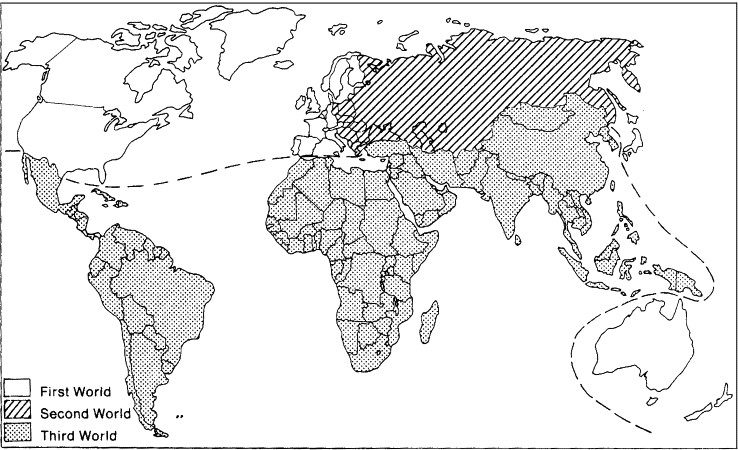The term “Third World” is frequently used, but its origins and true meaning are often misunderstood. When considering Mexico, a vibrant and complex nation, the question of whether it fits into this classification naturally arises. To answer whether Mexico is a 3rd world country, it’s essential to delve into the history of this term and understand its evolving meaning in a global context.
The phrase “Third World” emerged during the Cold War, a period of intense geopolitical tension between the Western capitalist bloc, led by the United States, and the Eastern socialist bloc, spearheaded by the Soviet Union. In 1952, French demographer Alfred Sauvy coined the term, drawing a parallel to the “Third Estate” in pre-revolutionary France – a group distinct from the nobility and clergy. Initially, “Third World” (or tiers monde in French) referred to nations that chose to remain non-aligned with either of these dominant blocs. This initial definition was primarily political, emphasizing neutrality rather than economic status.
The 1955 Bandung Conference in Indonesia underscored this political dimension. Here, a coalition of African and Asian countries sought to establish their collective identity and independence from both capitalist and socialist spheres of influence. Leaders like Tito of Yugoslavia, Nehru of India, and Sukarno of Indonesia championed this non-aligned movement, presenting a “third force” on the global stage. However, as the Cold War progressed, the non-aligned movement gradually lost its cohesive purpose as many nations became entangled within the orbits of the two major power blocs.
Over the 1960s, the term “Third World” underwent a significant semantic shift. As former colonies gained independence and the Cold War dynamic softened, the phrase increasingly adopted an economic connotation. The world began to be viewed less through a political lens of East versus West, and more through an economic lens of North versus South, rich versus poor. “First World” came to denote industrialized, market-based economies (the capitalist countries), while “Second World” described centrally planned, socialist states. The “Third World” increasingly became synonymous with “underdeveloped countries,” “developing countries,” or the “Global South,” highlighting a disparity in wealth and industrialization. While terms like “retarded countries” fell out of favor due to their derogatory nature, the “Third World” label often carried a subtle undertone of deficiency or lagging development.
By the 1970s, “Third World” was in widespread use, though its definition and geographical scope remained somewhat ambiguous. Some definitions took a geographical approach, broadly encompassing Africa, Asia, and Latin America, with some debate regarding parts of the Middle East, Japan, and South Africa. Other definitions emphasized structural factors like poverty and limited industrialization. Interestingly, this period also revealed a Eurocentric bias, as some relatively less wealthy European nations like Portugal and Greece were still categorized as “First World.” Conversely, socialist countries outside Eastern Europe with limited industry, such as Cuba and Laos, were often considered “Second World,” illustrating the lingering political undertones. Many nations classified as “Third World” were also part of the Non-Aligned Movement, formed in 1961, reflecting a shared sense of identity and common political and economic objectives, despite growing connections with either the Western or Eastern blocs.
 First, Second, and Third Worlds and the North–South division map illustrating Cold War era global classifications and economic disparities.
First, Second, and Third Worlds and the North–South division map illustrating Cold War era global classifications and economic disparities.
As decolonization progressed and numerous smaller nations achieved independence, the broad categorization of “Third World” became increasingly inadequate. By the late 1970s, over 120 countries, predominantly from Africa, Asia, and Latin America, could loosely be grouped as “Third World,” highlighting significant internal diversity within this grouping. The vast differences between a small island nation like Tuvalu and a resource-rich country like India, or a city-state like Singapore, became glaringly obvious. Factors like geography, natural resources, colonial history, culture, and industrialization levels varied dramatically. Applying a single “Third World” label to such disparate nations obscured more than it revealed about their individual development realities and future prospects.
Furthermore, distinctions based on resource wealth and industrialization became crucial. Some nations, particularly oil-exporting countries in the Middle East, experienced rapid economic growth, especially after the formation of OPEC in 1960 and the oil shocks of the 1970s. However, this resource-driven growth didn’t always translate into broader development in areas like education and healthcare, and could even create new challenges for oil-importing nations. Industrialization also played a key role, with some countries, termed Newly Industrializing Countries (NICs) – including Taiwan, South Korea, Hong Kong, Singapore, and in Latin America, Mexico and Brazil – achieving significant economic advancement.
So, returning to the initial question: Is Mexico A 3rd World Country? The answer is nuanced. Using the outdated Cold War-era definition, Mexico, during that period, might have been considered part of the “Third World” due to its non-aligned stance and developing economy. However, this categorization is overly simplistic and no longer accurately reflects global realities. Today, the term “Third World” is largely considered outdated and even pejorative. Development experts and international organizations prefer terms like “developing countries,” “emerging economies,” or “low- and middle-income countries” to describe nations progressing towards greater economic and social development.
Mexico, with its robust and diversified economy, significant industrial base, and membership in the OECD (Organisation for Economic Co-operation and Development), an organization primarily for high-income countries, is more accurately classified as an emerging economy or a newly industrialized country. While Mexico still faces development challenges, including income inequality and regional disparities, it has made significant strides in economic growth, infrastructure development, and social progress. Therefore, while historically the term “Third World” might have been loosely applied, it is inaccurate and outdated to label Mexico as a “3rd world country” today. Instead, understanding Mexico’s position within the spectrum of developing and developed nations requires acknowledging its complexities and progress, moving beyond simplistic and antiquated classifications.